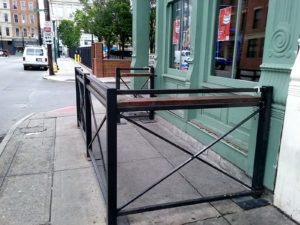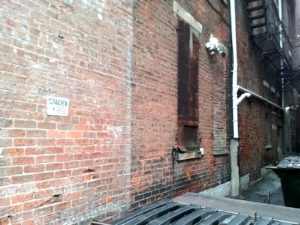
Hostile Design is a way to keep people from doing normal things that people would do – like sit, or lay down. These design elements are used throughout the urban landscape to exclude people from private and public spaces. Hostile Design does not include private security forces, CCV cameras, or other elements that require human interaction. But the signs that stand in proxy for security forces can be considered hostile design. Walking through Over-the-Rhine and Downtown Cincinnati, I was able to capture several forms of hostile design.

Credit: Dr. Mark Mussman
The most common element that I saw prohibits people from laying down. Whether it be a bench with a bar in the middle, as you see in Washington Park, or it be a circular bench set up, seen in a few places downtown, it’s clear that laying down is strictly prohibited. While this may make sense at bus stops, what does it mean when you cannot lay down in a park? Would those people who had a vision for a great city park agree with the mentality to make it as inhospitable as possible? I believe parks were created and designed for a respite from the hustle and bustle of city life. Now, instead of placing the bar in the middle of the bench, they make the benches too short to lay on, such as the bus shelters, including Government Square.

Credit: Dr. Mark Mussman
Another common element stops people from sitting at all. This could be as simple as placing a flower pot on an unused stairway, as seen on 14th Street in Over-the-Rhine, or it could be a slight slope on ledges that would typically be used for sitting. The slight slope makes it impossible to lay down, but it also makes your legs fall asleep if you sit on it for any length of time. Spikes and ridges may be the most shocking type of hostile design, but little fences, such as the one around the entire perimeter of Washinton Park are just as offensive. The ridges around the federal courthouse prevent people from sitting on their wall. The ridged metal in front of Holtman’s Donuts stops people, who may be waiting on a bus there, from having a comfortable place to sit. The recent removal of many of the bus benches throughout the city highlights the lack of value we put into our public transit system.

Credit: Dr. Mark Mussman
This is to contrast with the privatization of public spaces, like alleys and sidewalks, in the area. While people on fixed and low incomes are struggling to stand waiting for the bus, a few feet away restaurant outcroppings take up the majority of the sidewalk. People sitting, enjoying their expensive meals can enjoy the sidewalk space, but it is otherwise an offense to sit on the sidewalk. I have seen police officers drive up in their cruisers and tell people they cannot have their legs on the sidewalk, when they were sitting on the church steps. Threats of tickets and even arrest have been made, but restaurants claim several feet of the sidewalk making it very difficult to navigate your way down the street with a family or in a wheelchair, in order to serve alcohol on the sidewalk. These double standards need to stop.

Credit: Dr. Mark Mussman
I was first made aware of hostile design several years ago when I was in Santa Cruz, California. The University of California at Santa Cruz was designed to prevent students from engaging in political protests and marches. The winding walkways and meeting spaces were specifically engineered to prevent an uprising. This was done in the wake of student organizing in the 1960’s. UC Santa Cruz has become the model for student political suppression and campus design.

Credit: Dr. Mark Mussman
Last year, on a trip to Santa Cruz, I was hoping to find something called a “mosquito box.” You might be fooled into thinking that a mosquito box would be used to fight mosquitos – a well-known pest. Unfortunately, it is much more nefarious than that. If you’ve been in gentrifying areas, such as Walnut Hills or Over-the-Rhine, you might be surprised to hear classical music being blasted on the outside of buildings. This is an attempt to push out “undesirable” people from the area. This is also done at Washington Park and the Public Library downtown. I guess the thinking is that people don’t want to hear classical music, so they will move somewhere else. This is a type of mosquito box, but not the most egregious.

Credit: Dr. Mark Mussman
We have a true mosquito box here in Over-the-Rhine. On the side of Below Zero Lounge, there is a security camera and a mosquito box. Every time you walk by it announces “Warning, you are being videotaped” and gives off a high pitch noise. The high pitch noise is the mosquito box – while it does nothing to repel mosquitos, it causes headaches and forces people to leave the area. Young people are most susceptible to high pitch sounds, so they are more affected by it.
We should consider what it means to be a community and to be inclusive. Does preventing people from laying down solve our housing crisis? Does preventing people from sitting at all give the message that people are “blight” and should not be here? Let’s be honest with ourselves – this isn’t about preventing crime, this is about our collective denial and our inability to find solutions to hard problems. Next week, I hope to write about the Impaction Ordinance, which I believe is the policy version of hostile design. In the meantime, if you want to see some of this for yourself, schedule a walking tour with the Homeless Coalition.
Originally Published in Vol. 20, Issue 37 (May 19th – June 1st 2017)





















